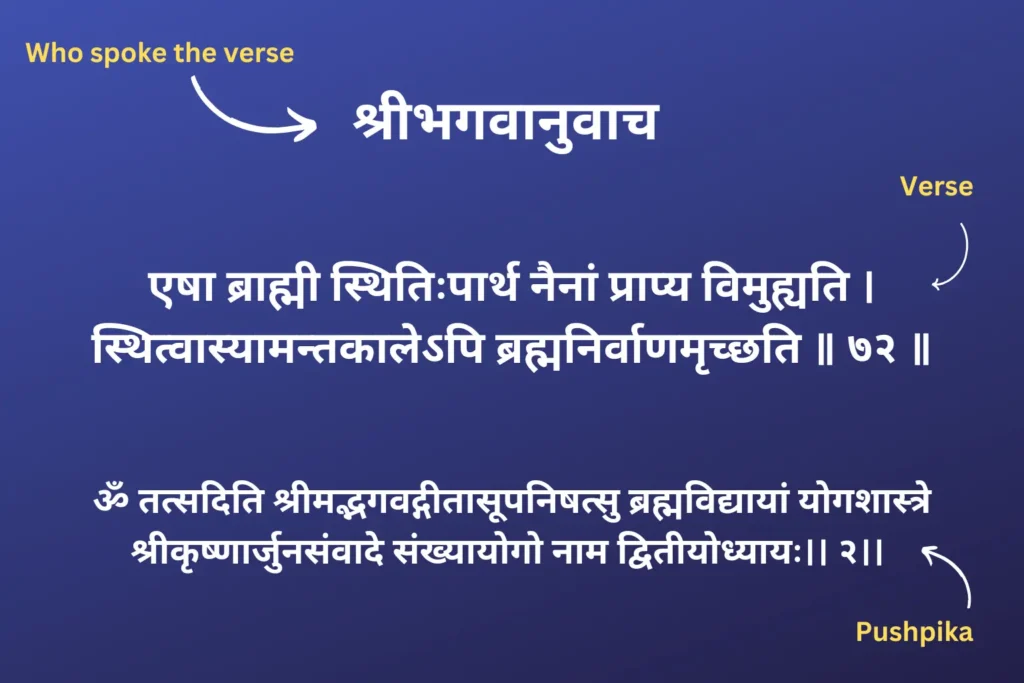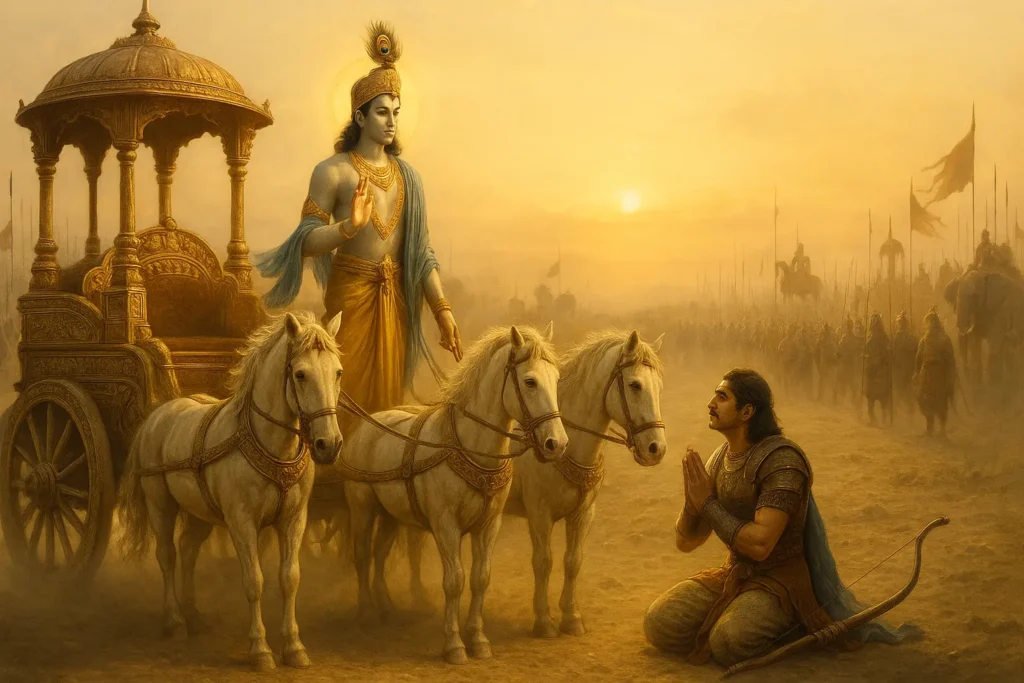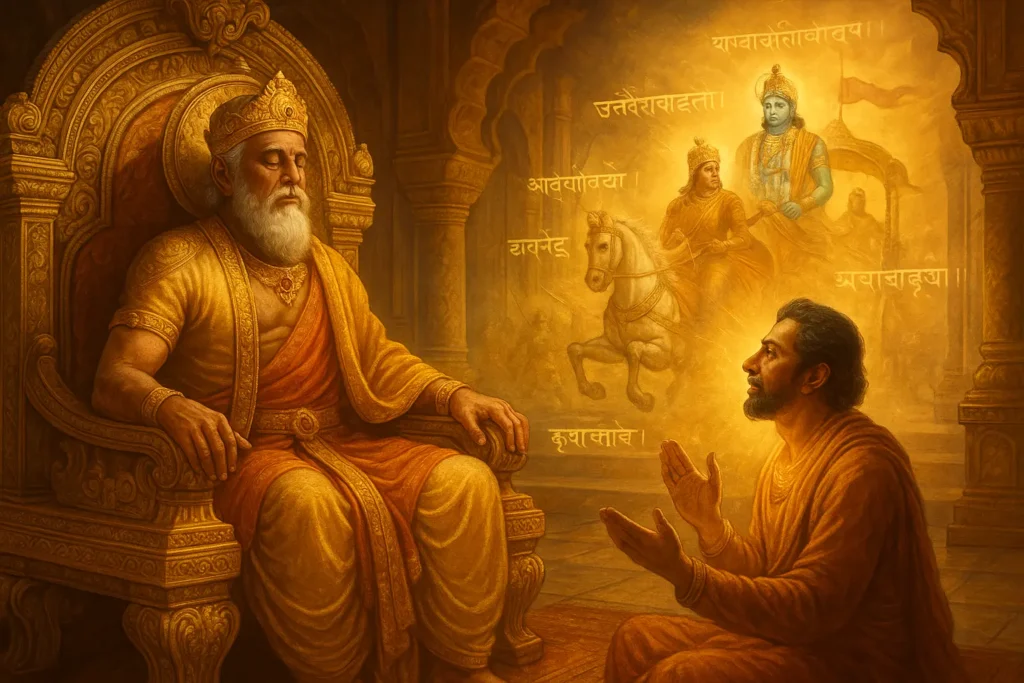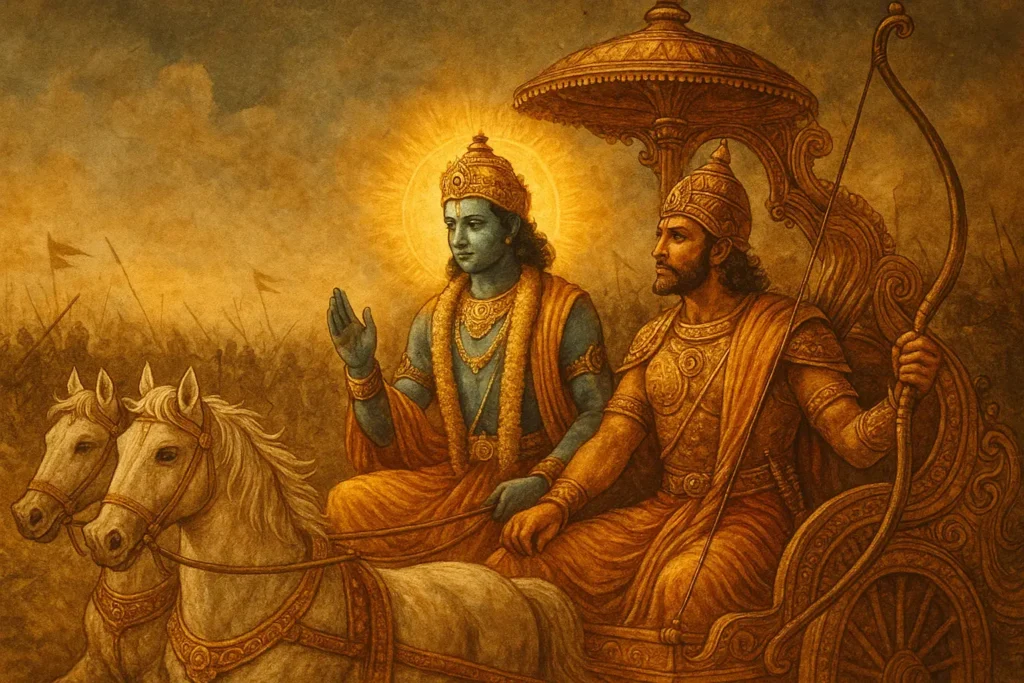Bhagavad Gita has 700 verses (shlokas) spanning over 18 chapters in all the books available today.
And the breakdown of these verses is as follows:
| Speaker | Number of verses |
| Krishna | 574 |
| Arjuna | 84 |
| Sanjaya | 41 |
| Dritrashtra | 1 |
| Total | 700 |
The topic would have ended here, BUT there is one twist!!
As we know, the Bhagavad Gita is a part of the Mahabharata written by Maharishi Ved Vyas.
And in the same section (Bhisma Parva: Chapter 43, Verses 4-5), he says the following verses:
षट्शतानि सविंशानि श्लोकानां प्राह केशव:।
अर्जुन: सप्तपञ्चाशत् सप्तषष्टिं तु संजय:॥
धृतराष्ट्र: श्लोकमेकं गीताया मानमुच्यते।
It says that in the Gita, Shri Krishna has spoken 620 verses, Arjuna has spoken 57 verses, Sanjaya has spoken 67 verses, and Dritrashtra has spoken 1 verse. This is said to be the magnitude of the Gita. (These numbers will be called “Gita’s magnitude” in the remaining article)
How is this possible??
If we count the number of verses from the above verse, it comes out to be 745!
Anatomy of a verse
A Bhagavad Gita verse contains these 3 parts (not always present but usually connected).
1. Who spoke the verse (उवाच’ ([someone] said))
2. The verse itself with the verse number
3. Pushpika (at the end of each chapter, describing the chapter’s name)

So, how many shlokas are there in Bhagavad Gita?
Many Indian saints and commentators on the Mahabharata have tried to understand this 745 number through their analysis.
Note: What I am writing in this section is their original analysis (the resource is at the end of this article). I am simply trying to explain that in English here. So, the following sections are only for the readers who want to dig deep into this actual figure given in the Mahabharata.
Is this figure 745 wrong somehow?
There is a story about the Mahabharat that comes in its Adiparva – Chapter 1: Verses 74-83 that on the advice of Lord Brahma, Maharishi Ved Vyas requested Lord Ganesha to write down the Mahabharat scripture.
On this, Lord Ganesha put a condition that if you don’t let my quill stop for a moment while writing, then only I can become the writer of this scripture. Ved Vyas also put a condition in front of Ganesha that you too should not write even a single letter in any context without understanding it. Lord Ganesha accepted it and sat down to write the Mahabharata.
While dictating, Ved Vyas ji used to utter such coded verses (with deep meaning) in between that Ganesha had to stop for a while to understand them. In that time, Maharishi Ved Vyas used to compose many more verses.
The shloka, which is related to the number of verses in the Bhagavad Gita, also seems to be such a coded shloka.
Therefore, some commentators, unable to establish the connection between this 745 number, consider these verses as interpolations.
But these seem to be the original verses of the Mahabharata only, because:
- Firstly, these are found in the oldest copies of the Mahabharata and
- Secondly, after deep contemplation of the Gita, these verses fit perfectly with the Gita standard.
Why is it called the “Bhagavad Gita”?
The opening of the first chapter shows that Arjuna is ready to fight the war. He asks Krishna to take his chariot between the two armies, and Lord Krishna strategically places his chariot in front of Bhisma and Dronacharya.
He did this to turn the war-oriented Arjuna towards the welfare-oriented Arjuna. The Lord had to use Arjuna as an instrument to impart the great teachings of the Gita for the welfare of the living beings.
So, seeing Bhishma and Dronacharya in front of him on the battlefield awakened Arjuna’s hidden attachment. Not only that, after placing the chariot in the middle, the Lord asked Arjuna to look at these Kuruvanshis (the family of King Kuru, which includes both Pandavas and Kauravas). Here, the Lord did not tell him to look at the sons of Dhritrastra. Even in saying this, the intention of awakening Arjuna’s attachment is clearly visible.
Therefore, it was natural for Arjuna’s attachment to occur by the word ‘Kuru’. Those whom Arjun was earlier calling ‘धार्तराष्ट्रस्य दुर्बुद्धेः’ (1.23) in the spirit of war, he now started calling them as his relatives – ‘दृष्ट्वेमं स्वजनं कृष्ण’ (1.28).
There is a possibility of the killing of relatives in war. Due to this attachment, Arjun becomes disoriented. Then he takes refuge in God and asks about his welfare. In reply, God gives divine sermons.
This shows that Arjun was not inclined to listen to the Gita on his own; rather, he was directed by the Lord. Hence, it is called ‘Bhagavad Gita‘, not ‘Arjuna Gita’ or ‘Krishna Arjuna Gita’.
The essence of calling it the ‘Bhagavad Gita’ is that even though there is a dialogue between Shri Krishna and Arjun, Arjun speaks only after being inspired by God; that is, it contains only God’s words.
‘उवाच’ ([someone] said) is also considered to be a shloka
There are 4 speakers in the Bhagavad Gita, and whenever they start speaking, this ‘उवाच’ appears along with their name.
Here is a complete list of ‘उवाच’ verses.
| श्रीभगवानुवाच (Lord Krishna said) | 28 times |
| अर्जुन उवाच (Arjuna said) | 21 times |
| संजय उवाच (Sanjaya said) | 9 times |
| धृतराष्ट्र उवाच (Dhritrashtra said) | 1 time |
The magnitude of the Gita (745 verses) can be proved by including ‘श्रीभगवानुवाच’ and ‘अर्जुन उवाच’ in the verse count.
Taking ‘उवाच’ as a complete verse can be seen in texts like “Sri-Durga-Saptshati”.
Krishna’s 620 verses
According to the Gita’s magnitude, there are 620 verses of Krishna, whereas according to the popular copy of the Gita, there are only 574 verses. Hence, we now need to consider the remaining 46 verses.
As mentioned, the feeling of speaking arose in the heart of the Lord 28 times. These 28 ‘श्रीभगवानुवाच’ should be considered as the count of verses. ‘श्रीभगवानुवाच’ are in the form of mantras because the Lord was speaking.
Similarly, after surrendering to the Lord, Arjuna, inspired by the Lord, as a seeker of the truth, spoke 17 times (अर्जुन उवाच) from (B.G. 2.54) to (B.G. 18.1). Hence, 45 (=28+17) are like divine mantras.
If these 45 ‘उवाच’ are added to the 574 verses spoken by Bhagwan as per the popular copy of the Gita, then 619 (=574+45) verses belong to Lord Krishna.
In the popular copy of the Gita, after the last ‘अर्जुन उवाच’ (B.G. 18.1), (B.G. 18.73) also belongs to Arjuna; but in the Gita’s magnitude, considering ‘अर्जुन उवाच’ as one verse, it has been included in Lord Krishna’s verses. This is because Arjuna spoke this verse after removing his illusion and becoming completely aligned with God. (More discussion on this point is in the FAQs.)
Therefore, a total of 620 verses of Krishna are justified.

Arjuna’s 57 verses
In the popular Gita books, there are 84 verses and 21 उवाच of Arjun; but in the Gita magnitude, only 57 verses of Arjuna have been mentioned.
As has been mentioned earlier, after his surrendering to Krishna, 17 verses in the form of ‘अर्जुन उवाच’ and (B.G. 18.73) have been included in the verses of Krishna.
The three ‘अर्जुन उवाच’ that came before his surrendering to Krishna (B.G. 2.7) have not been taken separately in the Gita magnitude but have been included under Sanjaya’s verse count.
(This is one of the styles of the Bhagavad Gita, in which the words spoken by one person come under the words of the other. For example, the words of Duryodhana, spoken in (B.G. 1.3-11), come under the words of Sanjaya. And the words of Prajapati Brahmaji, spoken in (B.G. 3.10-12), come under the words of Krishna. Similarly, Arjuna’s words ‘न योत्स्ये’ (B.G. 2. 9) come under Sanjaya’s words.)
Similarly, in the Gita’s magnitude, Arjuna’s words (comprising 26 verses) in (B.G. 1.21-23) and (B.G. 2.4-8) have been attributed to the words of Sanjay. Therefore, these 26 verses should be included in the counting of Sanjaya’s verses only and not in the counting of Arjun’s verses.
Thus, after subtracting the 26 verses as mentioned above and (B.G. 18.73) from the 84 verses of Arjuna, (= 84 – 27) 57 verses of Arjuna remain.
Sanjaya’s 67 verses
According to the popular version of the Gita, there are only 41 verses attributed to Sanjaya and 9 ‘संजय उवाच’; however, in the context of the Gita’s magnitude, 67 verses of Sanjaya have been mentioned.
In the Gita’s-magnitude, ‘संजय उवाच’ has not been considered as a separate verse, but has been taken in the verses of Sanjaya. Since the Bhagavad Gita is the dialogue between Krishna and Arjuna, only ‘श्रीभगवानुवाच’ and Krishna-inspired ‘अर्जुन उवाच’ have been considered as separate verses.

Secondly, the dialogue between Dhritrashtra and Sanjaya took place in Hastinapur, not in front of Krishna. The ‘उवाच’ of those whose dialogue did not take place in front of Krishna has not been considered as a verse.
Therefore, in the Pushpika, the Gita has been called ‘Shri Krishna-Arjuna Dialogue’, and not ‘Dhritarashtra-Sanjaya Dialogue.’ It has already been said that the 26 verses of Arjuna in chapters 1 and 2 should be considered as verses of Sanjaya. By adding these 26 verses to the verses of Sanjaya, a total of 67 verses (=26 + 41) is justified.
Dhritrashtra’s 1 verse
In the popular version of the Gita, there is only one verse attributed to Dhritarashtra, and in the Gita’s magnitude, only one verse of Dhritarashtra has been mentioned – hence, there is no difference in the quantity of this verse.
Like ‘संजय उवाच’, ‘धृतराष्ट्र उवाच’ has also been incorporated into the verses of Dhritrashtra, rather than being considered a separate verse.
Chapter-wise verse count as per the Mahabharata’s Gita-magnitude
| Chapters | Dhritrashtra | Sanjaya | Arjuna | Krishna | Total |
| 1 | 1 | 46 | 0 | 0 | 47 |
| 2 | 0 | 8 | 1 | 67 | 76 |
| 3 | 0 | 0 | 3 | 44 | 47 |
| 4 | 0 | 0 | 1 | 44 | 45 |
| 5 | 0 | 0 | 1 | 30 | 31 |
| 6 | 0 | 0 | 5 | 47 | 52 |
| 7 | 0 | 0 | 0 | 31 | 31 |
| 8 | 0 | 0 | 2 | 28 | 30 |
| 9 | 0 | 0 | 0 | 35 | 35 |
| 10 | 0 | 0 | 7 | 38 | 45 |
| 11 | 0 | 8 | 33 | 22 | 63 |
| 12 | 0 | 0 | 1 | 21 | 22 |
| 13 | 0 | 0 | 0 | 35 | 35 |
| 14 | 0 | 0 | 1 | 29 | 30 |
| 15 | 0 | 0 | 0 | 21 | 21 |
| 16 | 0 | 0 | 0 | 25 | 25 |
| 17 | 0 | 0 | 1 | 29 | 30 |
| 18 | 0 | 5 | 1 | 74 | 80 |
| Total | 1 | 67 | 57 | 620 | 745 |
Krishna-inspired Arjuna
When God or any liberated great person starts thinking about the welfare of a living being, then his welfare should be considered certain at that very moment. However, he does not experience it at that very moment. He comes to know about it later. Because when God or a great person removes the shortcomings present in him by making him express doubts, then he comes to know about his welfare (i.e., similarity with God).
When Arjuna left one Akshohini Narayani army (Krishna’s army) and accepted only the unarmed God, at that very moment, the feeling of Arjuna’s welfare arose in God’s heart. Because when the devotee gives up the luxuries, the responsibility of welfare comes on God. When God starts thinking about Arjuna’s welfare, his welfare is assured, but to remove the shortcomings present in him, God makes him have doubts, and after resolving them, destroys them just like fire destroys fuel.
By looking at the Bhagavad Gita, it is known that after surrendering to God, Arjuna first asks about the characteristics of a person of steady wisdom in B.G. 2.54. Here, Krishna-inspired Arjuna is speaking. If Arjun was not inspired by Krishna, then his doubts would have been about the war only. He would have doubts like whether to fight or not, or how to fight, etc., because he had come to the battlefield with the purpose of fighting. But here, Arjuna is asking about the highest spiritual principles. This proves that those doubts related to spirituality, which were in Arjun’s heart, were awakened by the inspiration of Krishna. Krishna-inspired Arjuna is asking about them only.
It appears that the verses in the form of ‘अर्जुन उवाच’ have been written by Maharishi Ved Vyas at the beginning of the doubts raised by the Krishna-inspired Arjun for the welfare of the people after surrendering to Krishna, and he has considered these verses as the verses of Krishna in the Gita magnitude.
To clearly understand the teachings of the Lord despite the Lord speaking continuously in the song, Ved Vyas ji has divided it into different chapters and has again included them in the verses of the Lord by giving ‘श्रीभगवानुवाच’ – form verses at the beginning of chapters 4, 6, 7, 9, 10, 12, 14, 15, and 16. Similarly, at the beginning of the verses, the doubts expressed by Krishna-inspired Arjuna, the verses in the form of ‘अर्जुन उवाच’ have also been included in the verses of Krishna himself. But since the doubts in those verses were Arjuna’s own, those verses have been included in the volume along with Arjuna’s verses.
With over three years of dedicated experience in studying and researching Indian scriptures, the author is passionate about sharing the profound wisdom of texts like the Bhagavad Gita, Puranas, and Upanishads. Through in-depth exploration of authentic commentaries, such as those by Gita Press, combined with thoughtful online research, the insights provided are both accurate and engaging.
The content aims to simplify complex spiritual teachings, making them relatable and applicable to modern life. By bridging ancient wisdom with contemporary understanding, the author seeks to inspire readers on their journey toward spiritual growth and self-discovery.




